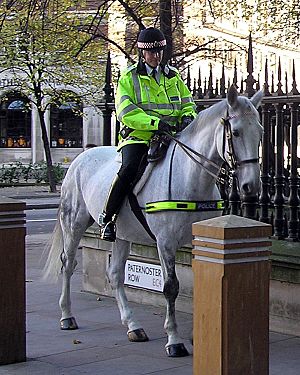Paternoster Row facts for kids

Paternoster Row was a street in the City of London that was a centre of the London publishing trade, with booksellers operating from the street. Paternoster Row was described as "almost synonymous" with the book trade. It was part of an area called St Paul's Churchyard.
The street was devastated by aerial bombardment during the World War II. In 2003 the street was replaced with Paternoster Square, the modern home of the London Stock Exchange, although a City of London Corporation road sign remains in the square near where Paternoster Row once stood.
As far back as the 12th century, the road was known as Paternoster Row, as it was the main place in London where Paternoster beads were made by skilled craftsmen. The beads were popular with illiterate monks and friars at the time, who prayed 30 Paternoster prayers (Latin for "Our Father") three times a day as a substitute for the 150 psalms recited a day by literate monks.
Contents
Printers and booksellers based in Paternoster Row
Note: Before c. 1762 premises in London had signs rather than numbers.
- The Globe - T. Cooper (1740)
- No. 1 - J Van Voorst (1851)
- No. 2 - Orr and Co. (1851), J. W. Myers (~1800)
- No. 3 Jan Van Voorst (1838)
- No. 9 - S. W. Partridge and Co. (1876)
- No. 12 - Trubner and Co (1856)
- No. 15 - Bagster and Sons (1825) (1851)
- No. 20 & 21 - F. Pitman, later F. Pitman Hart and Co. Ltd. (1904)
- No. 21 J. Parsons, (1792)
- No. 23 Piper, Stephenson, and Spence (1857)
- No. 24 - George Wightman (1831)
- No. 31 - Sheed & Ward
- No. 33 - Hamilton and Co. (1851)
- No. 37 - James Duncan (1825-1838) ; Blackwood and Sons, (1851)
- No. 39 - Longman, Hust, Rees, Orme, Brown and Green (1825), later Longman and Co. (1851) later Longmans, Green, and Co. (1902).
- No. 40 – West and Hughes (~1800)
- No. 47 - Chambers (1891), formerly occupied by Baldwin and Craddock
- No. 56 - The Religious Tract Society (1851)
- No. 60 - The Sunday School Union (1851)
- Oxford University Press - Bible warehouse destroyed by fire in 1822, rebuilt c. 1880.
- Sampson Low (after 1887)
- Thomas Nelson
- Hawes, Clarke and Collins (1771)
- H. Woodfall & Co.
- C Davis (1740)
- No, 27 Ivy Lane, Paternoster Row - Walton and Maberly (also at 28 Upper Gower Street) (1837-1857)
Others based in Paternoster Row
- No. 60 - Friendly Female Society, "for indigent widows and single women of good character, entirely under the management of ladies."
In popular culture
- The Paternoster Gang are a trio of Victorian detectives aligned with the Doctor in the television series Doctor Who, so named because they are based in Paternoster Row.
- In the episode "Young England" of the 2016 television series Victoria, a stalker of Queen Victoria indicates that he lives on Paternoster Row. (Coincidentally, the actress playing Victoria in the series, Jenna Coleman, had appeared in several episodes of Doctor Who that featured the aforementioned Paternoster Gang.)
See also
 In Spanish: Paternoster Row para niños
In Spanish: Paternoster Row para niños


